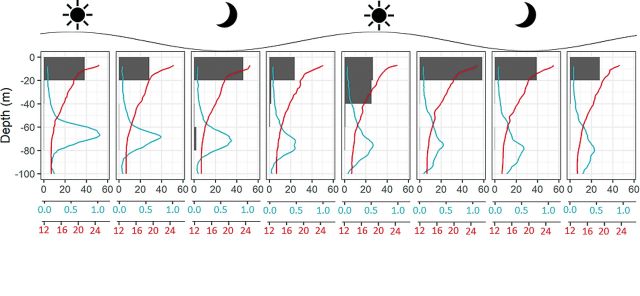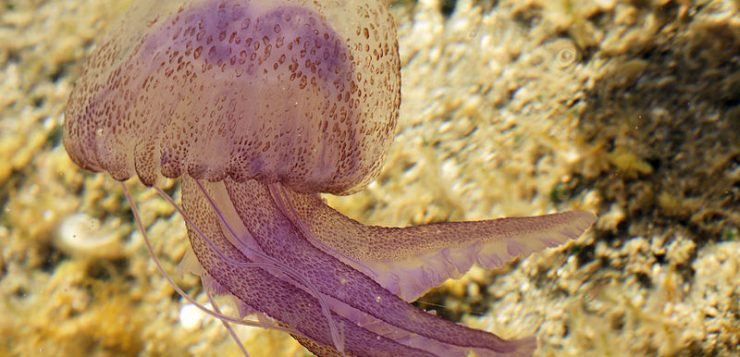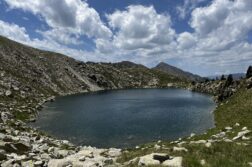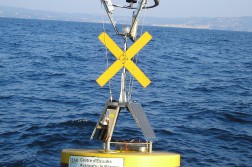Scientists from the Spanish Institute of Oceanography (IEO), in collaboration with researchers from other institutions, including Ana Gordoa from the Department of Marine Ecology of the Center for Advanced Studies in Blanes (CEAB-CSIC), have published a work that allows a better understanding of the environmental factors that determine the reproduction of Pelagia noctiluca, one of the most common jellyfish in the Mediterranean. This study shows that the abundance of this jellyfish in its early stages of life in early summer, is strongly linked to the amount of phytoplankton in the water in late spring, results that allow us to better understand the possible causes of the massive appearances of these jellyfish on the beaches.
The group of researchers has studied for six years how environmental conditions affect the distribution and abundance of the early stages of life of Pelagia noctiluca, a very common jellyfish in the Mediterranean, and which sometimes forms blooms of hundreds of individuals that reach the beaches. The results of the study have been published in the journal Marine Ecology Progress Series.
Warm water and the presence of microscopic algae, two increasingly common factors
It has been observed that in years when the water temperature has been warmer during the winter and spring months, combined with a special abundance of microscopic algae, the reproductive success of Pelagia noctiluca has been favored. . Global warming makes these two factors becoming more frequent and this fact may explain the massive arrival of Pelagia noctiluca on the coasts of the western Mediterranean over the past few decades. If we add to this that this jellyfish tolerates a wide range of temperatures and is able to survive in conditions of food shortage, we better understand the causes of its rapid proliferation.

Although the greatest abundance of food is found in intermediate water layers, researchers have confirmed that the early stages of Pelagia noctiluca remain in the shallower layers of the water column, where warm temperature favors their growth and development. In addition, they have shown that these small jellyfish are more abundant in areas with a high concentration of surface chlorophyll, which determines 90% of the changes in their annual abundance around the Balearic islands.
This study is vital to understanding of the reproductive ecology of Pelagia noctiluca and the factors influencing its population changes, which is a fundamental step in predicting the massive occurrences of this jellyfish.
In order to draw up some oh the conclusions of this research, the scientist have used the results of the ATAME coordinated project, where the Spanish Institute of Oceanography (IEO), the University of Cádiz, the AZTI center and the Center for Advanced Studies in Blanes (CEAB-CSIC) have participated, and where also Ana Gordoa (CEAB-CSIC) was the main researcher of one of the subprojects: Laying pattern and reproductive parameters of bluefin tuna breeders and impact of predation of Pelagia noctiluca on eggs and larvae.
The article that have just published isvery relevant, not only to understand the proliferation of Pelagia noctiluca, but also to assess the impact of this jellyfish on the survival of bluefin tuna eggs and larvae, because the two species coincide in space and time in the waters of the Mediterranean Sea. The voracity of Pelagia noctiluca on the eggs oh the bluefin tuna seriously compromises the future of this species.
–
References:
Daniel Ottmann, Diego Álvarez-Berastegui, Laura Prieto, Rosa Balbín, Francisco Alemany, Øyvind Fiksen, Ana Gordoa, Patricia Reglero, 2021.Abundance of Pelagia noctiluca early life stages in the western Mediterranean Sea scales with surface chlorophyll. Mar Ecol Prog Ser 658:75-88. https://doi.org/10.3354/meps13423.
Ana Gordoa, José Luis Acuña, Roser Farrés, Kathrin Bacher, 2013. Burst Feeding of Pelagia noctiluca ephyrae on Atlantic Bluefin Tuna (Thunnus thynnus) Eggs. PloS one, 8(9), e74721.




